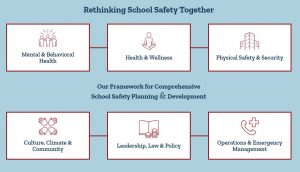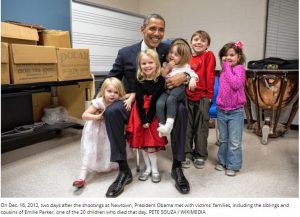Oct
30

Posted by Susan Halpin on October 30th, 2020
Posted in: Blog, NLM Resources, Public Health
Tags: K-12, National Summit on School Safety, Safe and Sound Schools, school safety, school violence

Rising to the occasion is nothing new for school administrators and teachers. What is new — is that many of us are finally  recognizing just how important and dedicated those who teach our children are and always have been. In the extraordinary times of COVID19 our K-12 school administrators, educators and staff have quickly taken on new responsibilities such as adapting lessons to be delivered virtually (at a moment’s notice), continually monitoring the mental health of the students and some are even delivering meals to families because food insecurity is even more prevalent than it was pre-pandemic.
recognizing just how important and dedicated those who teach our children are and always have been. In the extraordinary times of COVID19 our K-12 school administrators, educators and staff have quickly taken on new responsibilities such as adapting lessons to be delivered virtually (at a moment’s notice), continually monitoring the mental health of the students and some are even delivering meals to families because food insecurity is even more prevalent than it was pre-pandemic.
Over the past 5 months the NER has been collaborating with the Massachusetts PTA, specifically it’s committee on Health and Wellness providing online health resources, education and some funding to assist the committee in its efforts to educate families about vaping, vaccines, mental health and other health-related initiatives facing families. Through this work, the National PTA extended an invitation to PTA partners to attend the National Summit on School Safety that I attended virtually each afternoon on October 7-9/
The summit was put on by the Safe and Sound Schools organization (https://www.safeandsoundschools.org ) founded by Michele Gay and Alissa Parker, two mothers who lost children in the 2012 shootings at Sandy Hook Elementary School in Newtown Connecticut. Safe and Sound Schools defines their very specific mission on their website:
Our mission is to support school crisis prevention, response, and recovery, and to protect every school and every student, every day.
We have always — and only — focused on school safety. We are firm in our mission and firm in our resolve, and we will continue to advocate for and provide research-based education, tools, and resources to ensure the safest possible learning environment for the youth of our nation.
Safe and Sound Schools promotes and provides resources for a comprehensive framework for school safety planning and development. This framework includes:
I’d like to share some of the highlights with you from this very informative and engaging 3-day conference.
The summit opened on the first day with a special presentation from the FBI Violence Reduction Unit (VRU), it was a new documentary film called In the Aftermath (https://www.fbi.gov/video-repository/in-the-aftermath-093020.mp4/view). The film sheds light on the personal stories and lessons learned by those directly impacted by school shootings. It was impactful and sad to hear the life-long journeys of survivors, victims’ families, first responders and communities in the aftermath of tragedy they have experienced. I learned best practices gleaned from lessons learned about how to provide trauma-informed care to those involved in similar tragedies, as well as resources and ideas to prevent future tragedies and promote safe and sound schools.
Following the film Michele Gay, gave the keynote presentation for Day 1. Michele is the mother of Josephine Gay who was just 7 years-old when she died in the Sandy Hook School Shooting. Michelle shared her story and the lessons she learned that sparked her involvement in the creation of the Safe and Sound School organization.
Next, Dr. Lina Alathari, Chief, National Threat Assessment Center, U.S. Secret Service, discussed her research, and the assessment and training using a multidisciplinary or team approach that is most successful for schools when addressing safety.
The afternoon session began with a presentation by a leadership panel that discussed School Safety in the Era of Pandemic. Each day a leadership panel presented a specific topic of safety from each of their unique perspectives. The panel presentation was followed by an opportunity to attend a small group break out session for discussion with each person on that day’s leadership panel.
Day two started with a keynote presentation from Dr. CJ Huff, the former Superintendent of Joplin Schools in Joplin, Missouri. Dr. Huff shared the story of how his school district recovered from a deadly EF-5 tornado that damaged or destroyed 10 of the 19 schools in his district in May of 2011. He highlighted the importance of community-wide leadership, teamwork and consistent focus on what’s best for children.
The afternoon leadership panel provided presentations about how to achieve resilience after being involved in a tragedy.
Day Three began with a presentation from Clayton Douglas and Dr. Frank Straub, Director of the Center for Mass Violence Response Studies at the Police Foundation. On December 13th, 1987 after years of bullying at school and physical abuse at home, Clayton Douglas took a gun to school planning to shoot his teachers and classmates. Through a powerful video presentation and follow up discussion with Dr. Frank Straub, Clayton shared his personal story of that day and how that experience gave him insights into the prevention and intervention of acts of school violence that he uses now to help schools prevent gun violence.
The conference ended with a powerful keynote presentation from a school counselor in rural Tennessee, Molly Hudgens. When Molly was beginning her career, the school shooting at Columbine High School happened. After Columbine, Molly devoted her career to making sure that no child fell through the cracks in her school community. She learned all she could about “recognizing red flags” and even provided training to educators in her state about how to foster meaningful connections with students because her research consistently pointed to the idea that “connection” is essential for school safety. After 20 years, of research and providing training to others, a student walked into her office with a gun and declared his plan to implement a school shooting. Molly shared her story of how connection and compassion saved Sycamore Middle School from a school shooting.
I came away from this conference with many resources the NER can share with our network partners who are involved with K-12 and higher education.
The Safe and Sound Schools website has toolkits that can be downloaded and used to assess and improve safety. The resource library on the website also provides links to information related to all aspects of safety, for example:
Cyber Safety, Bullying, First Aid & Trauma Care, Substance Abuse, School Leadership Law and Policy, Gender and Sexuality as well as many more topics.
As a result of attending the summit, I am planning to reach out to Safe and Sound Schools to share the NLM Disaster Preparedness, Response and Recovery Resources (https://disasterinfo.nlm.nih.gov/ ) in the hopes they and their partner organizations will find these resources useful and perhaps consider posting them on their resource list on the website. Who knows, perhaps there are more ways NNLM can partner with this organization doing this very important work to keep our schools safe!
